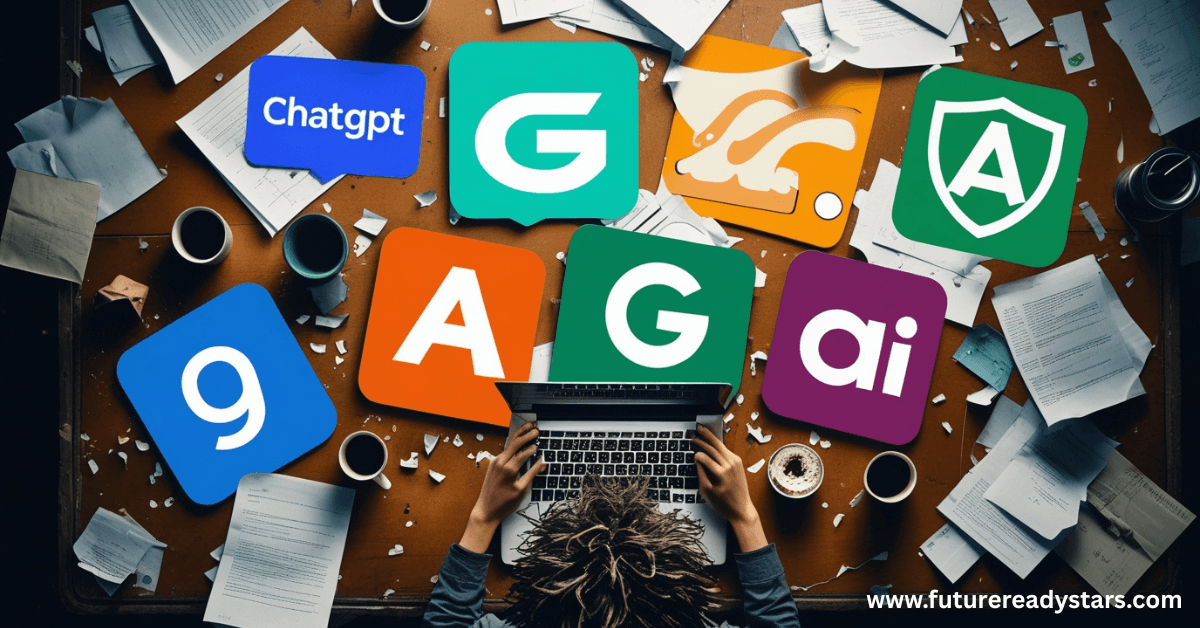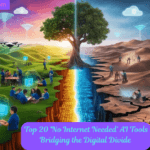
Introduction
Banned AI tools for students are sparking a quiet revolution in U.S. classrooms.
It’s midnight in Ohio. Emily, a high school junior, stares at her laptop, struggling with an essay on climate change. As the deadline looms, and her ideas are scattered. Desperate, she turns to ChatGPT, one of the most banned AI tools for students. Within moments, the AI delivers a crisp outline, complete with facts and arguments she hadn’t considered. She smiles, relieved. Meanwhile, her principal is drafting a memo to ban AI tools for students, convinced they’re stealing her ability to think for herself.
This tension isn’t isolated across the USA. Artificial intelligence is storming into classrooms, offering students a lifeline of instant help, creative boosts, and personalized learning. But schools are pushing back, slapping bans on these tools faster than you can say “plagiarism.” Why? Concerns about cheating, misinformation, and the slow fade of critical thinking. Yet, students are hooked—and for good reason.
In this article, we’ll dive into the top 15 banned AI tools for student, explore why educators are hitting the panic button, and uncover why students can’t let go. From ChatGPT’s meteoric rise to popular aids like Photomath these tools are rewriting the rules of education—and sparking a debate that’s anything but black-and-white.
Also read: Top 20 AI Tools Teachers Need in 2025 for Better ClassroomsUnveiling the Top 15 Banned AI Tools Among Students
here are the AI tools sparking the most debate:

1. ChatGPT (OpenAI)
What it does: A chatbot that writes essays, answers questions, and even codes.
Why Schools Are Banning It: Schools fear that students will use ChatGPT to generate essays, complete homework, and bypass the learning process.
Why Students Love It: It helps brainstorm ideas, summarize complex topics, and explain difficult concepts in a conversational way.
2. Grammarly
What it does: An AI-powered writing assistant that polishes grammar, style, and clarity.
Why Schools Are Banning It: Some institutions believe that AI-generated corrections prevent students from mastering grammar on their own.
Why Students Love It: It enhances writing by catching mistakes, improving clarity, and expanding vocabulary.
3. QuillBot
What it does: A paraphrasing tool that rewrites text to sound fresh and original.
Why Schools Are Banning It: This paraphrasing tool makes it easy for students to rewrite assignments and bypass plagiarism detection.
Why Students Love It: QuillBot helps reword ideas, making writing clearer and more natural.
4. Photomath
What it does: Solves math problems by scanning a photo and providing step-by-step explanations
Why Schools Are Banning It: Educators worry that students rely on it to get answers instead of developing problem-solving skills.
Why Students Love It: It breaks down complex equations into easy-to-follow steps, helping students understand math concepts better.
5. Wolfram Alpha
What it does: A computational engine that solves equations and answers factual queries
Why Schools Are Banning It: Schools fear that students will depend on it rather than practicing manual problem-solving.
Why Students Love It: It not only provides answers but also explains the underlying concepts in detail.
6.Turnitin AI Detection
What it does: A plagiarism detector that also flags AI-generated content.
Why Schools Are Banning It: Ironically, Turnitin’s AI detection often leads to false positives, causing frustration among students.
Why Students Love It: Many use it to check their own work before submission, ensuring originality.
7. Socratic (by Google)
What it does: A homework helper that explains concepts across subjects.
Why Schools Are Banning It: Socratic uses AI to provide instant answers to questions across multiple subjects, making teachers wary of its misuse.
Why Students Love It: It explains concepts clearly using step-by-step guides and visual explanations.
8. GitHub Copilot
What it does: An AI coding assistant that suggests code as you type.
Why Schools Are Banning It: Some schools believe it undermines programming education by reducing the need for students to write code from scratch.
Why Students Love It: It speeds up coding assignments and provides useful coding suggestions in real-time.
9. DeepL Translator
What It Does: An AI-powered translation tool known for its accuracy.
Why Schools Are Banning It: Some schools worry that AI-powered translators make students overly dependent on technology for language learning.
Why Students Love It: It provides highly accurate translations, making it easier to learn and understand new languages
10. Perplexity AI
What It Does: A research tool that summarizes multiple sources into concise answers.
Why Schools Are Banning It: Schools fear that AI-powered search engines like Perplexity encourage students to bypass traditional research methods.
Why Students Love It: It simplifies research by providing well-structured summaries in seconds.
11. Tome AI
What It Does: Tome AI generates AI-powered presentations and organizes content into slides.
Why Schools Are Banning It: Educators worry that automated presentations diminish creativity and effort.
Why Students Love It: It saves time by organizing ideas into professional-looking slides.
12. SlidesAI
What It Does: An AI tool that automates slide creation for presentations.
Why Schools Are Banning It: Some believe that AI-generated presentations lack originality and student input.
Why Students Love It: It enhances visual storytelling while reducing time spent on formatting.
13. Scribbr AI Proofreader
What It Does: Scribbr AI Proofreader is an AI-powered tool that improves grammar and writing quality.
Why Schools Are Banning It: Schools argue that AI proofreading reduces students’ engagement with their own writing and editing process.
Why Students Love It: It helps refine essays and catch grammar mistakes that might go unnoticed.
14. Speechify
What It Does: Speechify is an AI-powered text-to-speech app that converts written text into audio.
Why Schools Are Banning It: Some educators worry that it encourages students to listen instead of actively reading.
Why Students Love It: It’s a game-changer for auditory learners and students with reading difficulties.
15. Caktus AI
What It Does: Caktus AI is an AI-powered homework assistant that generates answers and explanations for various subjects.
Why Schools Are Banning It: This AI-powered homework assistant can generate essays and answer test questions, raising concerns about academic honesty.
Why Students Love It: It provides quick, AI-generated answers and explanations for homework questions.
Also read: Top 10 AI Gadgets for Students in 2025Why Schools Ban AI Tools: Top 5 Concerns
There are five main reasons why schools banned AI tools for students.
1. “Cheating Epidemic”
At the heart of the controversy is the fear that AI equals academic dishonesty. Tools like ChatGPT can write essays or solve equations in seconds, which some schools see as a fast track to cheating.
The Twist: Critics argue this view is overly simplistic, especially for neurodiverse students who benefit from AI as a learning aid. Disability advocate Mara Kincaid puts it bluntly: “Calling AI accommodations ‘cheating’ is like calling glasses cheating.”
So, is it really cheating—or just modern-day support?
2. Loss of Control
Another major concern is that AI undermines the teacher’s role. When AI tools begin to grade papers, suggest feedback, or answer complex questions, it can feel like machines are replacing mentors.
Real-World Example: In a Virginia school district, an AI grading tool flagged bias in assessments—prompting teachers to label it “an attack on professionalism.”
To many educators, AI’s flawless outputs feel less like help and more like a threat.
3. Privacy Nightmares
From biometric wearables to focus-tracking apps, AI can get a little too personal. Schools worry about student data being collected without proper safeguards.
The Irony? Some institutions ban tools like SleepyAI (which tracks student alertness) while using surveillance apps like GoGuardian to monitor browsing activity. This double standard isn’t lost on students—and it’s fueling growing distrust.
4. Equity Gaps
On paper, banning AI tools might seem fair. But in practice, it often deepens the divide between students who have personal tech and those who rely solely on school devices.
The Result: Rural and low-income students are cut off from helpful tools, while their wealthier peers continue using AI at home without restriction.
So instead of leveling the playing field, bans can reinforce existing inequalities.
5. “We’re Not Tech Support!”
Even when schools want to embrace AI, there’s a glaring issue—lack of training. Most teachers aren’t AI experts, and many are already overwhelmed by the demands of digital classrooms.
As one middle school teacher put it on Reddit: “I’m already battling TikTok in class—AI is another layer of chaos.”
Without proper professional development, AI can feel more like a burden than a benefit.
The Middle Ground: How Schools Can Regulate AI Instead of Banning It
Rather than banning AI outright, innovative schools are testing balanced approaches:

While some schools have taken a strict approach and banned AI tools for students outright, others are exploring more balanced strategies that harness AI’s benefits while addressing concerns about academic integrity. Here are some forward-thinking approaches schools can take:
1️⃣ Supervised AI Use Zones Instead of Blanket Bans
Instead of outright prohibiting AI, some schools are setting up supervised environments where students can use approved AI tools for specific tasks. For example, Minnesota’s “AI Zones” allow students to explore AI applications within controlled classroom settings,
promoting responsible usage. This approach encourages ethical AI literacy while ensuring students don’t misuse the technology.
2️⃣ Student-Led AI Governance Committees
Empowering students to participate in tech-related decision-making fosters responsibility and accountability. At Denver’s South High School, a student-tech council, comprising students, IT staff, and educators, votes on AI tool approvals. As a result, the school has managed to integrate AI responsibly—without imposing bans—ensuring technology supports learning rather than replacing critical thinking.
3️⃣ “AI Drivers Ed” Courses for Digital Literacy
Many students lack formal training in AI ethics, misinformation detection, and responsible tech use. ethics to curb AI cheating in education. That’s why California has launched pilot programs that teach students how to:
- Properly cite AI-generated content in research papers
- Identify and challenge deepfakes and AI-driven misinformation
- Understand cybersecurity risks associated with AI-powered tools
Just like driver’s education ensures safe road practices, AI literacy courses prepare students for responsible tech use in academia and beyond.
4️⃣ Public AI Resource Hubs for Equal Access
Banning AI tools disproportionately affects students from lower-income backgrounds who may rely on free educational AI to bridge learning gaps. To address this, New York City has introduced “Tech Lending Hubs“, where students can borrow approved AI-powered learning tools and devices for free. This initiative ensures all students can benefit from AI without restrictions while maintaining academic integrity.
Conclusion: Should AI Be Banned or Embraced?
The debate over ChatGPT banned in schools isn’t about tech—it’s about trust. As one student tweeted: “You can ban our apps, but you can’t ban our need to survive your broken system
Banning AI tools isn’t a perfect solution. While concerns about academic integrity are valid, AI also opens new doors for education. Instead of outright bans, schools should focus on teaching students how to use AI responsibly.
These tools aren’t just shortcuts—they’re powerful assistants that can enhance learning when used correctly. The challenge is finding the right balance between preventing misuse and fostering innovation in education.
Fears of AI cheating in education and losing learning. School administrators at public schools, such as the New York City Public Schools, do not allow the use of AI. They want to keep academic integrity and fairness. Using AI can break honor codes. This makes it unfair for students who decide to do their own work.
Students are very good with technology. Even though schools try to stop them, they often find ways around the rules. Some students use their own devices and internet connections. Others team up to share access. The fact that AI tools are available outside school shows how limited these bans are. It also shows that we need better solutions.
What do you think? Should AI tools be banned in schools, or should they be integrated into learning? Which of these 15 tools would you fight to keep in school? Tell us below!
For more ways AI’s helping in education, check out my articles at futurereadystars.com—let’s keep them shining



